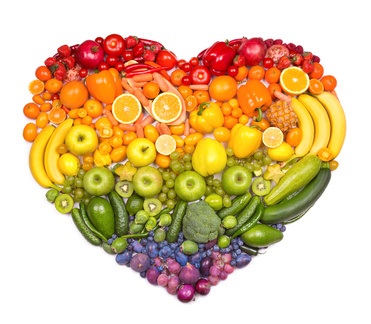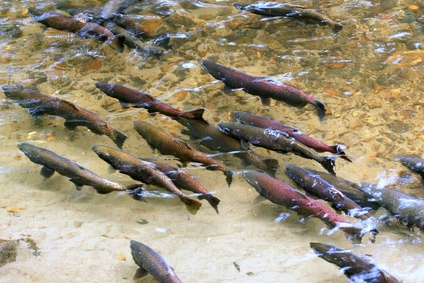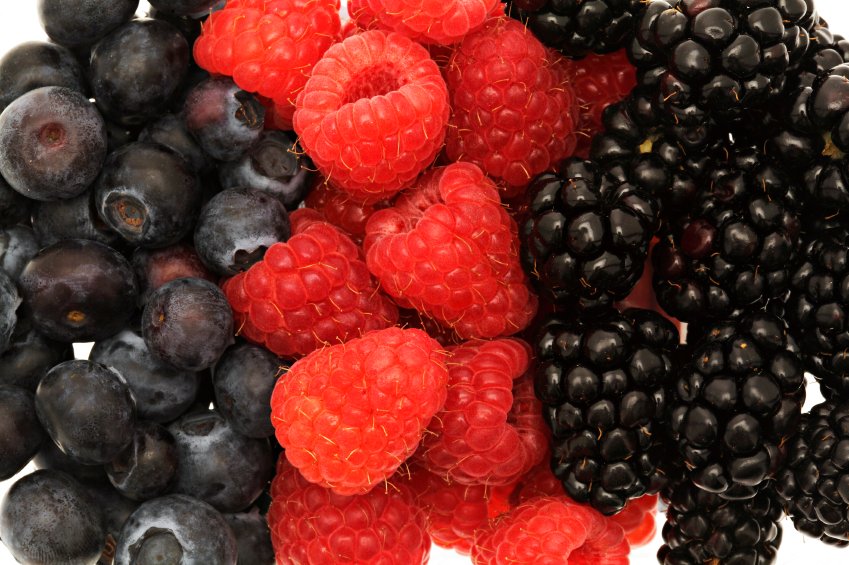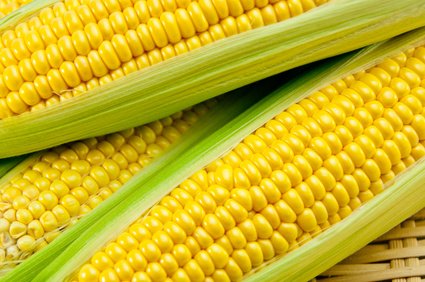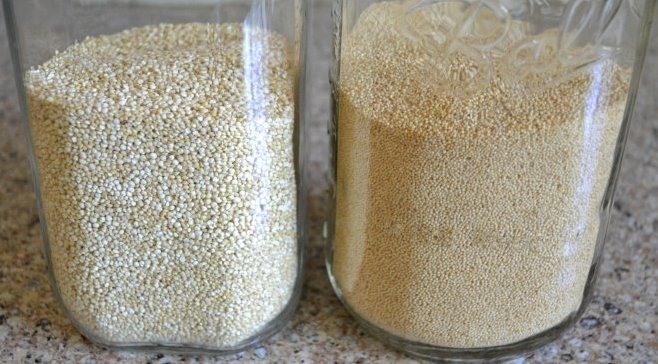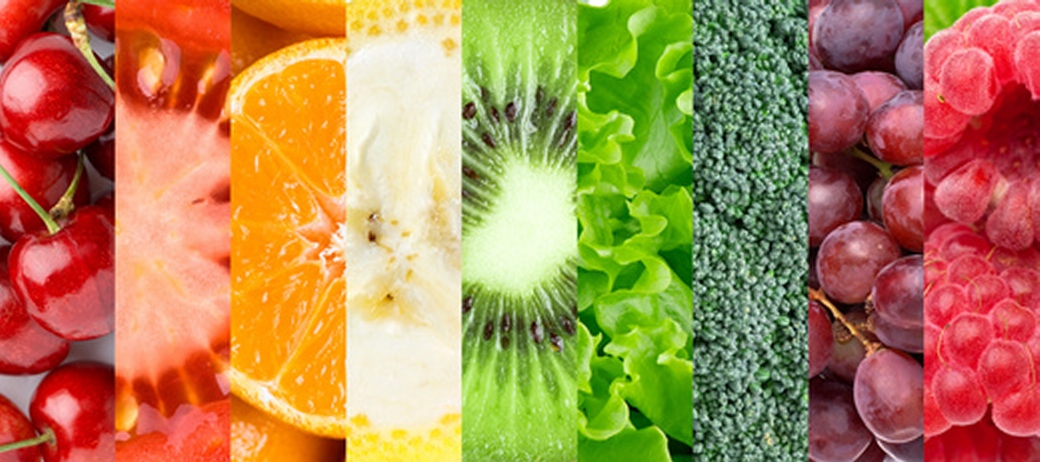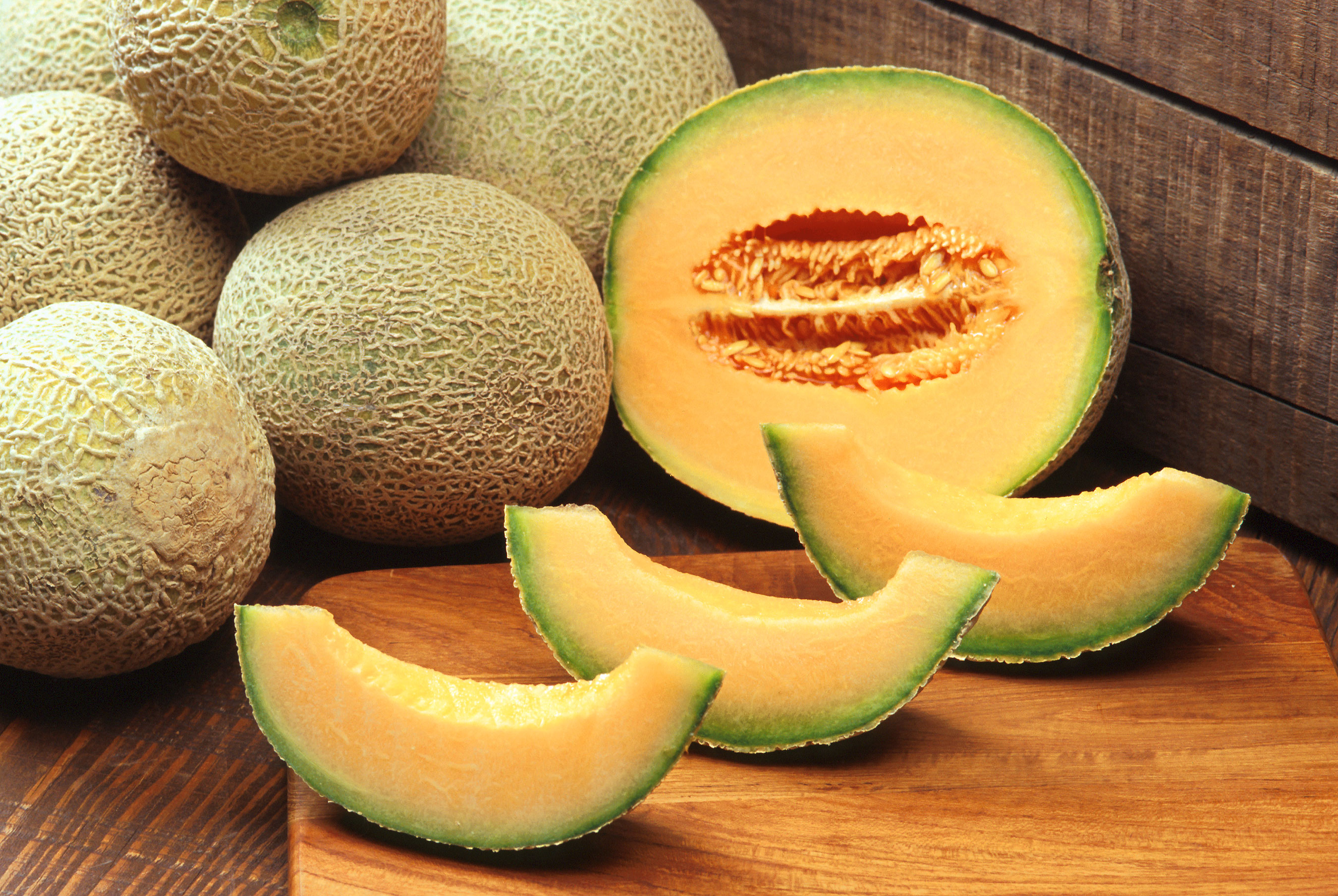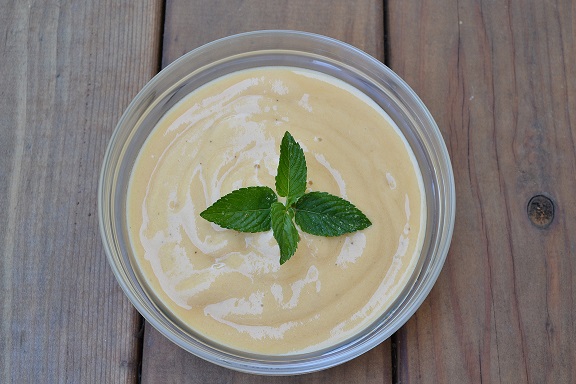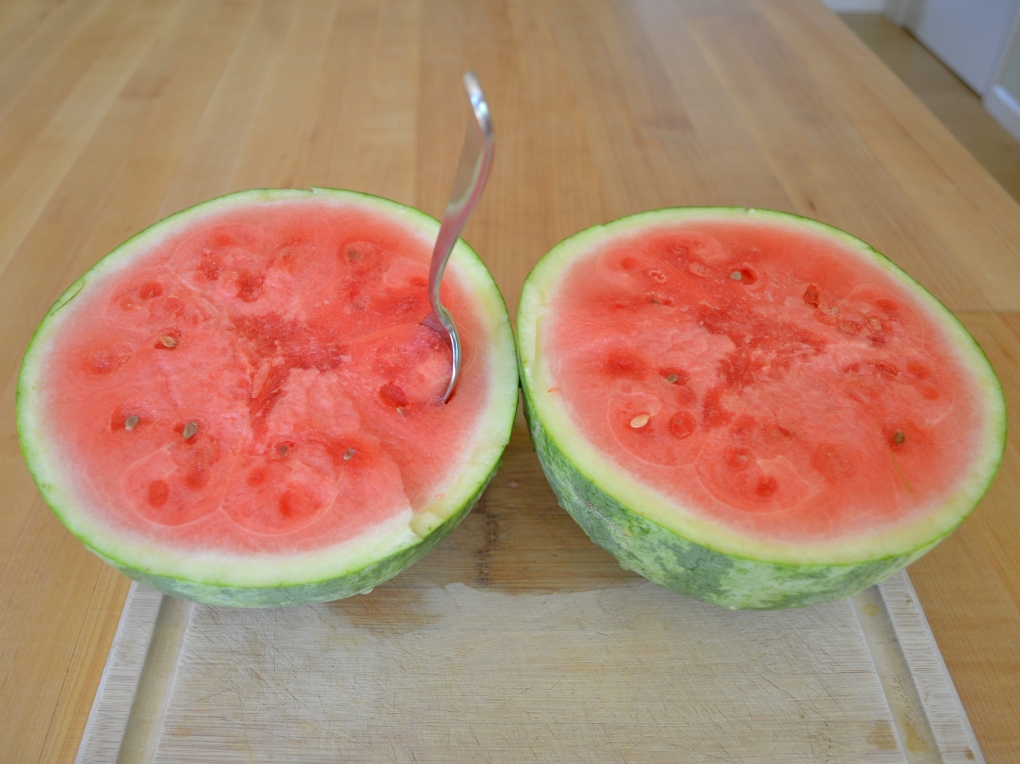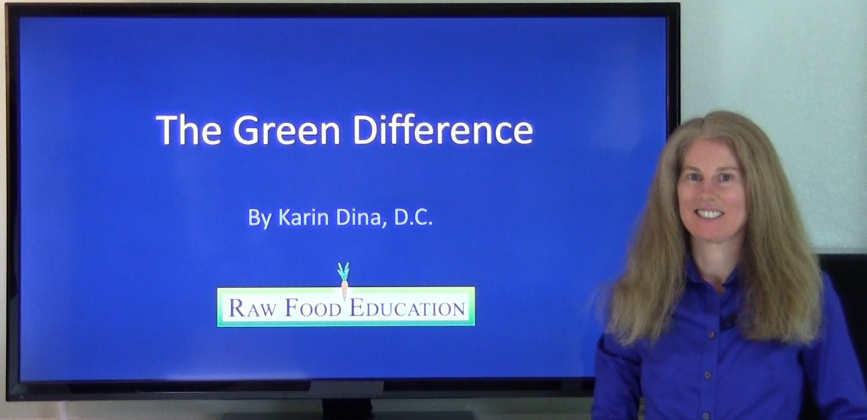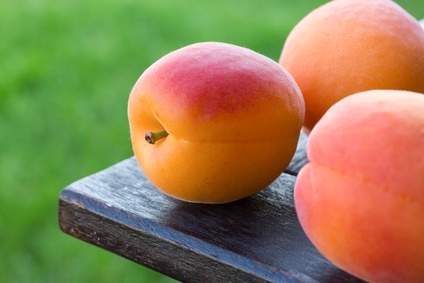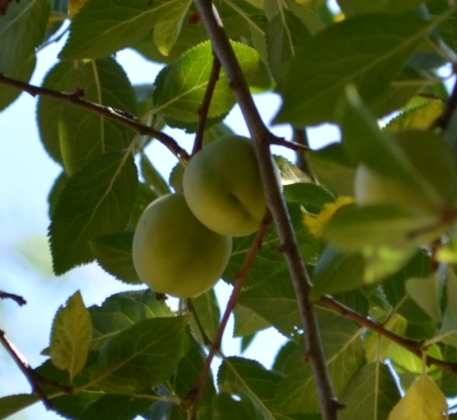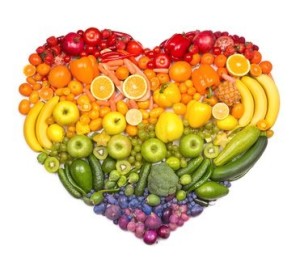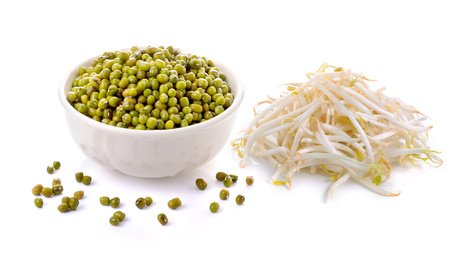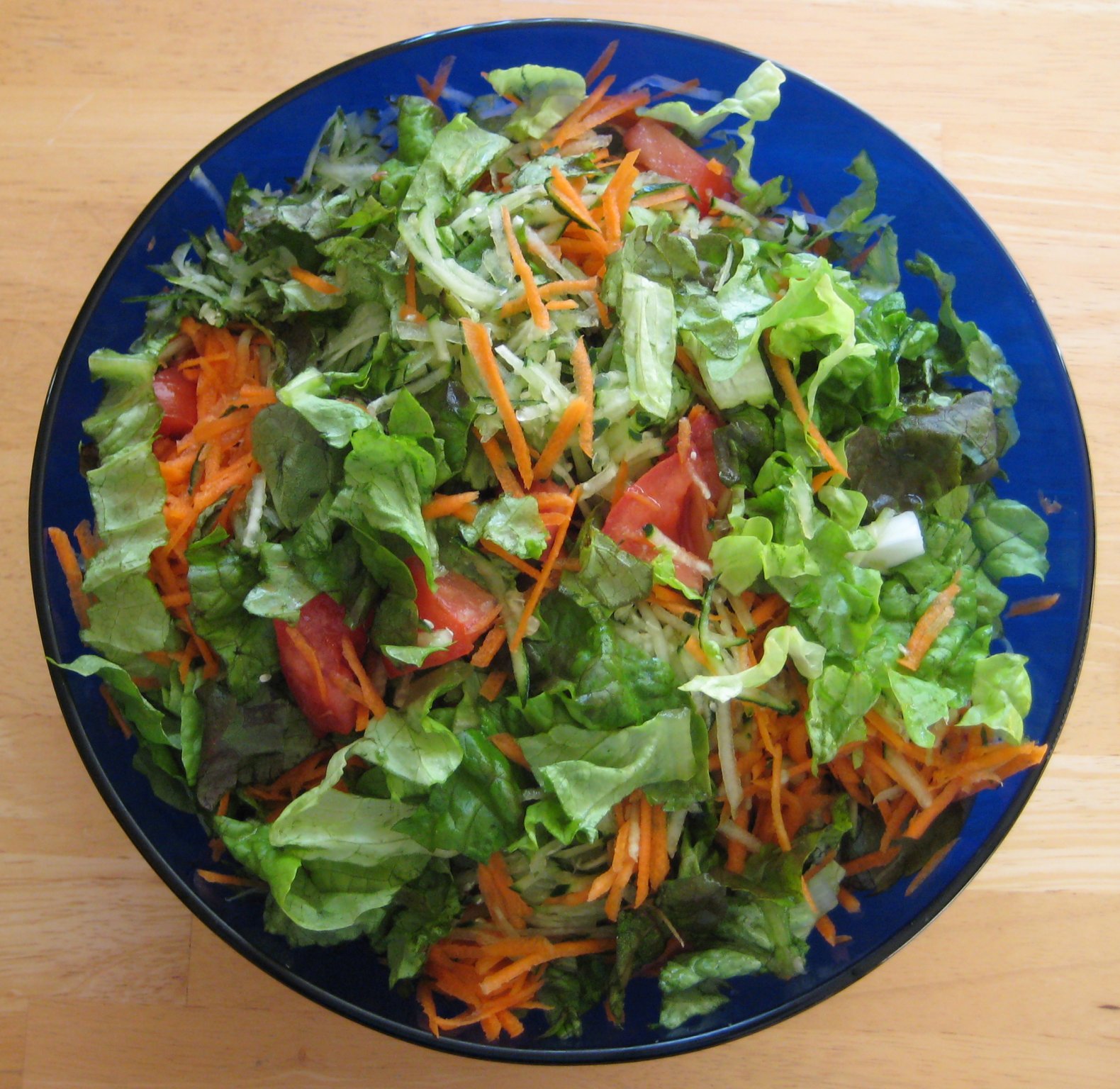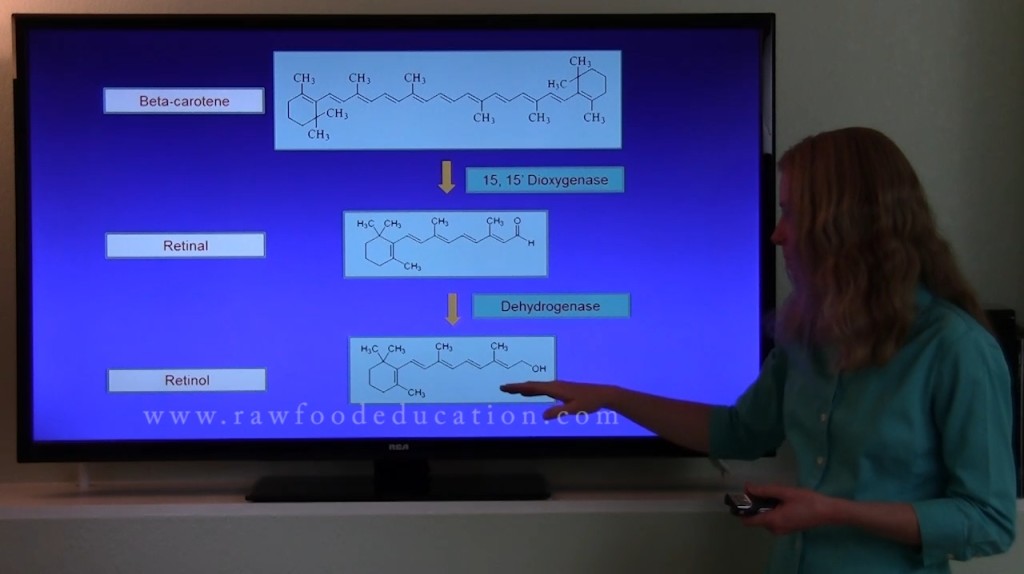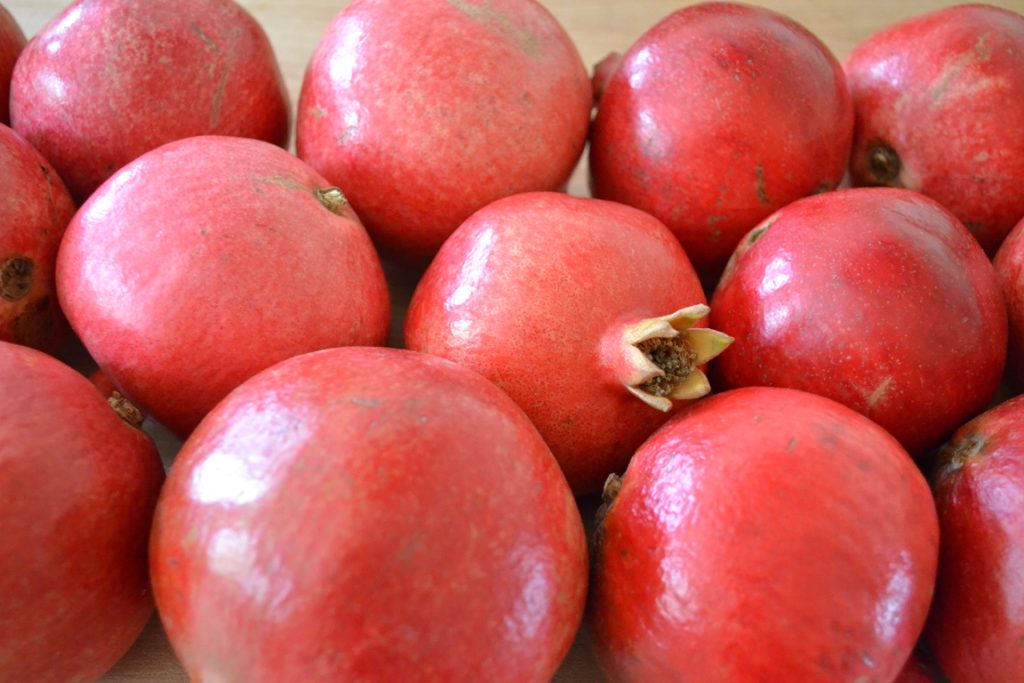 I have to say that I absolutely LOVE pomegranates. I always look forward to the month of November in anticipation of making and enjoying fresh pomegranate juice, which has a flavor unlike any other fruit I’ve tried before, along with its deep red color calling attention to its rich antioxidant content.
I have to say that I absolutely LOVE pomegranates. I always look forward to the month of November in anticipation of making and enjoying fresh pomegranate juice, which has a flavor unlike any other fruit I’ve tried before, along with its deep red color calling attention to its rich antioxidant content.
I wasn’t always this enthusiastic about pomegranates; it wasn’t until years into my raw food journey that I came to truly appreciate them. After all, pomegranates cannot be easily peeled and eaten or bitten into like so many of the more common fruits we enjoy. Some of you may know this from experience. The good news is that there are many ways to enjoy pomegranates, the first being juice.
Before we get started, let’s take a closer look at what a pomegranate actually is.
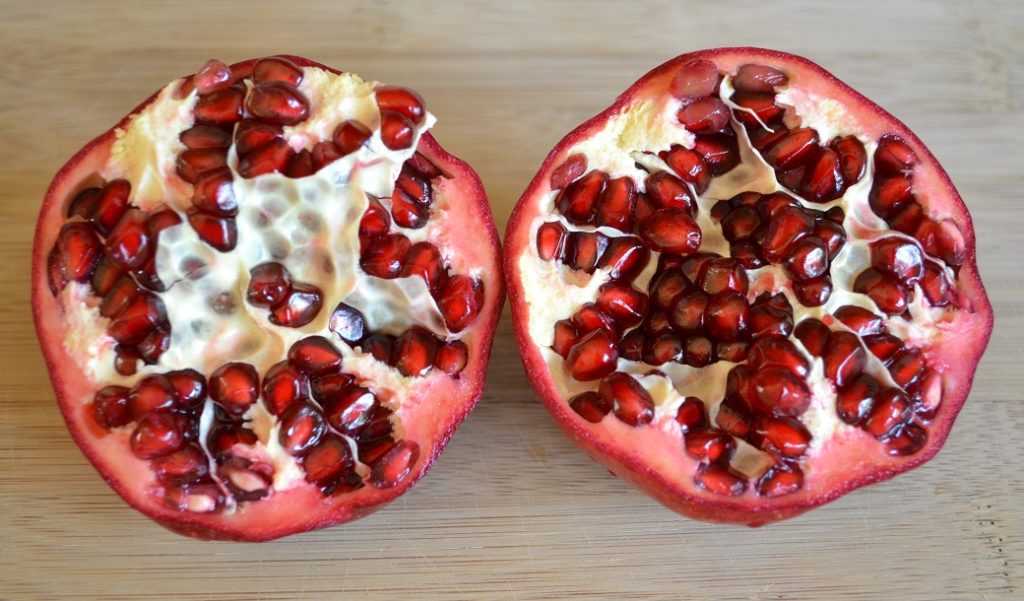 When you open a pomegranate, you will see tough fiber interspersed with pockets of individual seeds each surrounded by a dark red fluid-filled pouch. These are called arils. When one juices a pomegranate, they are releasing the dark red fluid from these arils. Please know that using a nice bamboo cutting board for pomegranate preparation may lead to stains. I learned this the hard way, and now I use a cutting surface that doesn’t stain.
When you open a pomegranate, you will see tough fiber interspersed with pockets of individual seeds each surrounded by a dark red fluid-filled pouch. These are called arils. When one juices a pomegranate, they are releasing the dark red fluid from these arils. Please know that using a nice bamboo cutting board for pomegranate preparation may lead to stains. I learned this the hard way, and now I use a cutting surface that doesn’t stain.
There are many techniques and juicers that can be used to make pomegranate juice, with our favorite method being the use of our manual citrus press.
 We find that using a press does not break down the white pomegranate seeds, but rather, separates the juice from the seeds and fiber, resulting in a dark red colored juice, which we love. We have found that the use of some electrical juicers breaks down the white pomegranate seeds, yielding a lighter tasting pink juice which is a combination of red pomegranate juice and broken down white pomegranate seeds. Our taste preference is the dark red juice.
We find that using a press does not break down the white pomegranate seeds, but rather, separates the juice from the seeds and fiber, resulting in a dark red colored juice, which we love. We have found that the use of some electrical juicers breaks down the white pomegranate seeds, yielding a lighter tasting pink juice which is a combination of red pomegranate juice and broken down white pomegranate seeds. Our taste preference is the dark red juice.
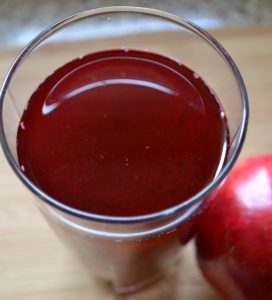 In order to get as much juice as possible out of our pomegranates, we cut the pomegranates into quarters. Cutting the pomegranates in half also works, but we have found that we get more juice if we cut the fruit in quarters. If you do not have a manual citrus press, a hand-held citrus juicer will work as well. Although, you may not get as much juice out of the pomegranates that you would with a citrus press. Before we got our citrus press, we used a hand-held citrus juicer and had good results. Be aware that juicing with either press method may lead to the red juice spraying onto surrounding counter tops, walls, and clothing. I wish I had known this the first time I juiced pomegranates.
In order to get as much juice as possible out of our pomegranates, we cut the pomegranates into quarters. Cutting the pomegranates in half also works, but we have found that we get more juice if we cut the fruit in quarters. If you do not have a manual citrus press, a hand-held citrus juicer will work as well. Although, you may not get as much juice out of the pomegranates that you would with a citrus press. Before we got our citrus press, we used a hand-held citrus juicer and had good results. Be aware that juicing with either press method may lead to the red juice spraying onto surrounding counter tops, walls, and clothing. I wish I had known this the first time I juiced pomegranates.
 We have found that juicing ripe pomegranates produces juice with notably less astringency than ripe pomegranates. How can you tell when a pomegranate is ripe? When the skin is cracked. We’ve rarely seen pomegranates with cracked skin for sale in stores; we’ve mostly seen them growing on trees in yards or at farmers markets. Does this deter us from purchasing pomegranates without cracked skins? No. We just realize that such pomegranates may have some astringency to their taste.
We have found that juicing ripe pomegranates produces juice with notably less astringency than ripe pomegranates. How can you tell when a pomegranate is ripe? When the skin is cracked. We’ve rarely seen pomegranates with cracked skin for sale in stores; we’ve mostly seen them growing on trees in yards or at farmers markets. Does this deter us from purchasing pomegranates without cracked skins? No. We just realize that such pomegranates may have some astringency to their taste.
The flavor of pomegranates can be strong regardless if fully ripe or not, so we often enjoy the combination of pomegranate juice with fresh squeezed orange juice. The orange juice counters the astringency of the pomegranate juice with some sweetness and makes for a nice base juice for our smoothies.
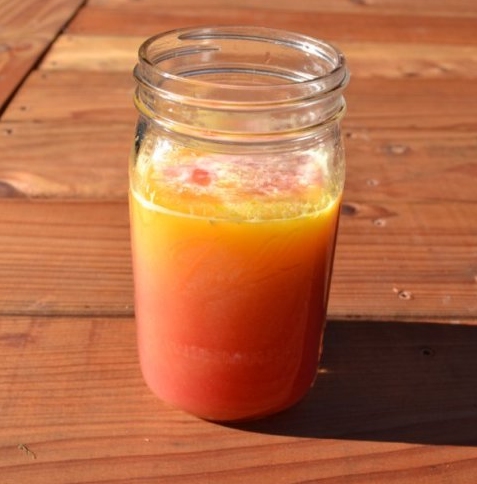 Here is a basic recipe for orange pomegranate juice:
Here is a basic recipe for orange pomegranate juice:
- Three medium Valencia oranges
- One medium pomegranate
We like to make smoothies with this juice recipe. Here is one of our favorites:
- 1 cup orange-pomegranate juice
- 2 cups chopped dandelion greens
- 1 cups dark cherries
- 3 bananas
- ½ cup mangoes
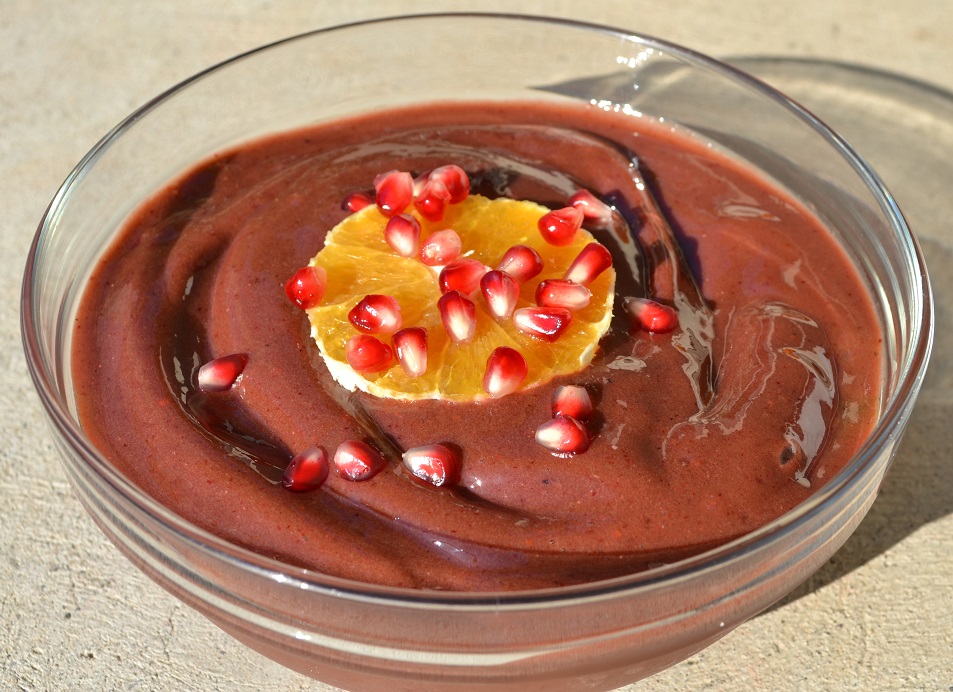 I personally really enjoy this recipe with orange pomegranate juice, but I like straight pomegranate juice even more, especially in my morning smoothies. One of my favorite smoothies is my Ultra-Antioxidant Supercharged Energy smoothie that I enjoy a couple hours before I go on a run at this time of year. I even recently achieved two personal running records after eating this smoothie:
I personally really enjoy this recipe with orange pomegranate juice, but I like straight pomegranate juice even more, especially in my morning smoothies. One of my favorite smoothies is my Ultra-Antioxidant Supercharged Energy smoothie that I enjoy a couple hours before I go on a run at this time of year. I even recently achieved two personal running records after eating this smoothie:
- ½ cup pomegranate juice
- 2 cups chopped dandelion greens
- ½ cup blackberries
- ½ cup blueberries
- 3 bananas
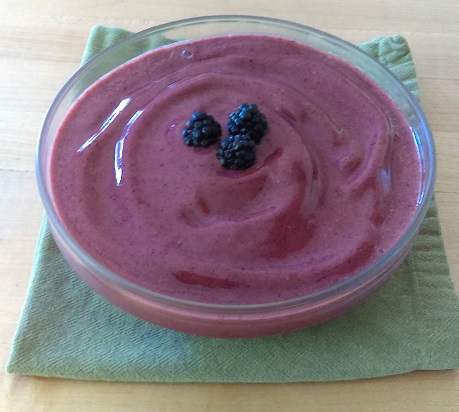 Here are some nutrient highlights of the ingredients used to create this smoothie:
Here are some nutrient highlights of the ingredients used to create this smoothie:
| Menu | Adult DRI | |
| Vitamin B1 | 0.55 | 1.1 – 1.2 mg |
| Vitamin B2 | 0.74 | 1.1 – 1.3 mg |
| Vitamin B3 | 4.84 | 14 – 16 mg |
| Folate | 230 | 400 mcg |
| Vitamin C | 120 | 75 – 90 mg |
| Vitamin E | 7 | 15 mg |
| Calcium | 277 | 1000 – 1200 mg |
| Iron | 6 | 8 – 18 mg |
| Magnesium | 188 | 310 – 420 mg |
| Potassium | 2543 | 4700 mg |
| Zinc | 2.5 | 8 – 11 mg |
Given that the number of calories in this smoothie is 672, this nutrient profile is impressive!
In addition to pomegranate juice, there are so many additional ways to enjoy pomegranates around the holidays. I was recently asked how to remove the seeds from pomegranates to use in recipes. So, here are the steps I use:
First, I change into clothing that I am not concerned with if I get stained, then I score the middle of the pomegranate:
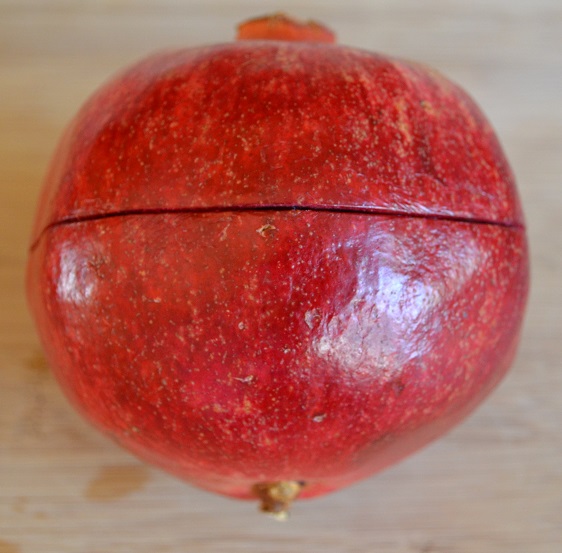 Then, I separate the two halves of the pomegranate by essentially tearing the two halves apart over a bowl to catch any juice that comes out in the process. Inserting a spoon into the score can assist with separating the two halves.
Then, I separate the two halves of the pomegranate by essentially tearing the two halves apart over a bowl to catch any juice that comes out in the process. Inserting a spoon into the score can assist with separating the two halves.
 To get the fluid-filled seeds (arils) out of the halves, I turn the halves inside out.
To get the fluid-filled seeds (arils) out of the halves, I turn the halves inside out.
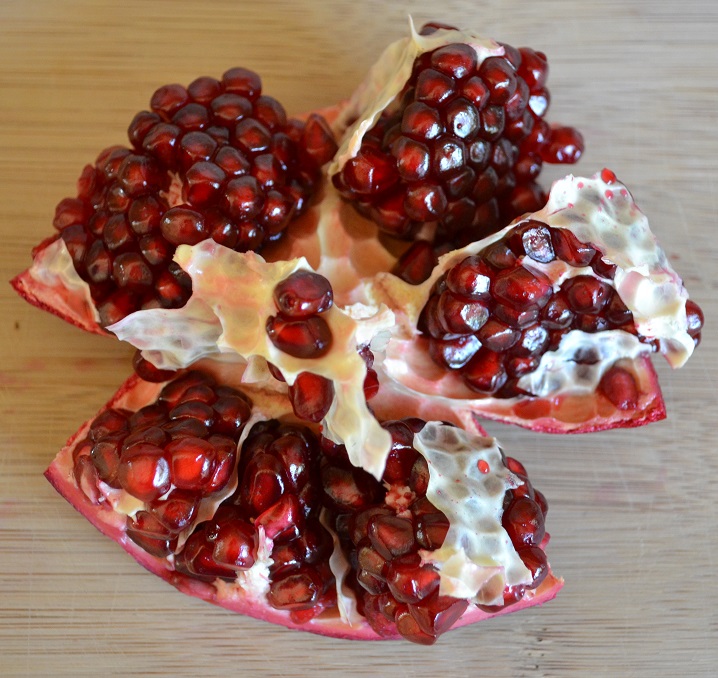 And then I remove the arils by hand over a bowl filled with water. The arils will sink to the bottom of the bowl and the pith will float.
And then I remove the arils by hand over a bowl filled with water. The arils will sink to the bottom of the bowl and the pith will float.
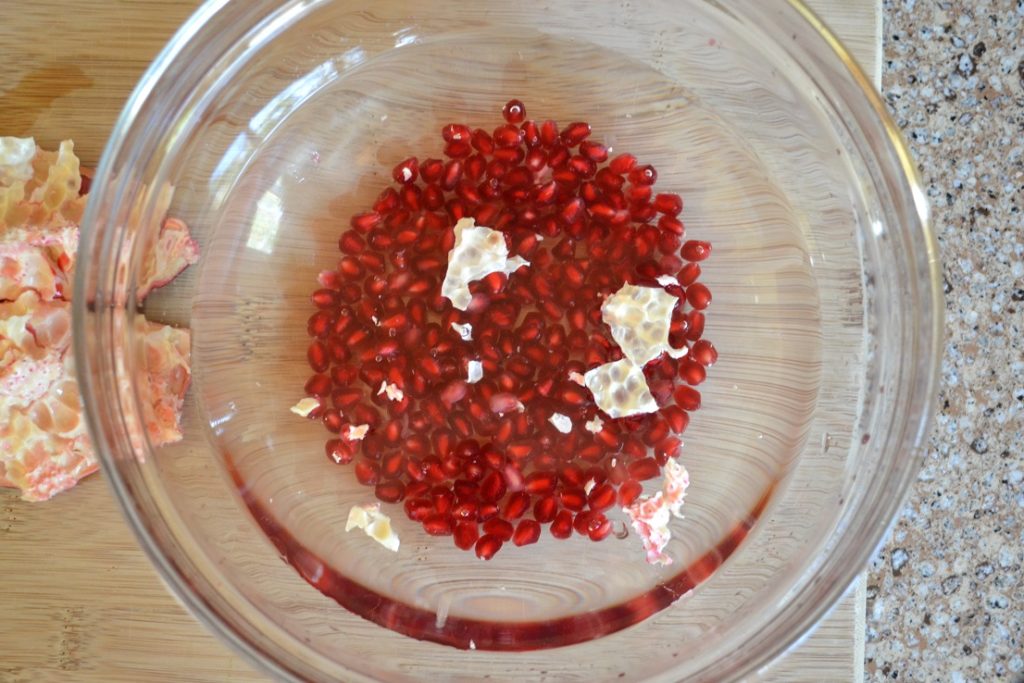 I then remove the floating pith pieces and drain off the water from the arils. Here is a photo of the drained arils:
I then remove the floating pith pieces and drain off the water from the arils. Here is a photo of the drained arils:
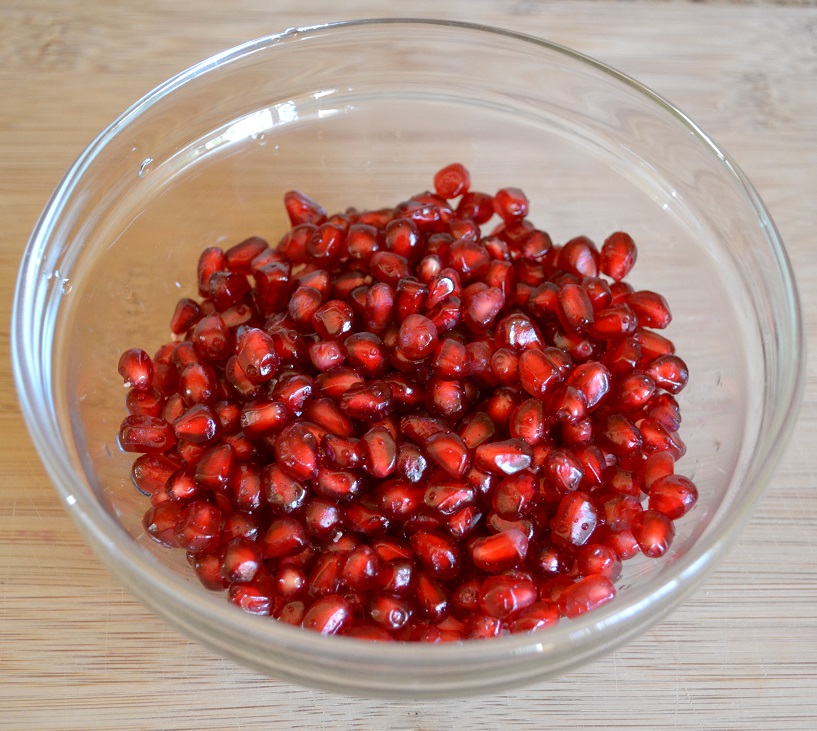 Now, what do we do with these pomegranate arils? We love them in salads.
Now, what do we do with these pomegranate arils? We love them in salads.
Many people ask us how much salad we eat regularly and are surprised when they see the actual amount. Over my almost 28 years of being on this raw food path, my salads seem to get bigger every year. When I first started, I thought for sure that I would be hungry on raw food because my vegetable intake reference point was a small dinner-sized salad with about a cup or two of lettuce, half of a tomato, and a slice of onion drenched in some type of dressing. After shifting to a more raw plant-based diet, my salads obligatorily grew significantly in size. Now my salads look more like this:
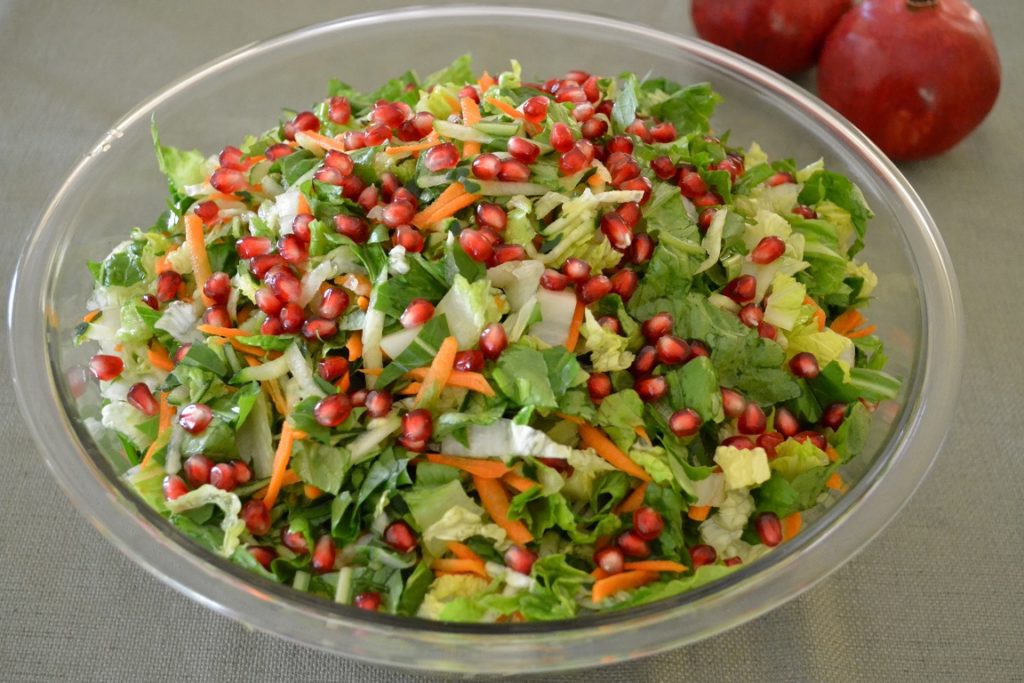 Here are the ingredients in the salad:
Here are the ingredients in the salad:
- 5 cups shredded cucumber
- 3 cups shredded carrots
- 10 cups chopped or torn romaine lettuce
- 3 cups chopped or torn dandelion greens
- ½ cup pomegranate arils (when available)
I love dandelion greens, but I know their taste is not for everyone. Nutrient-wise they are a powerhouse, but there certainly are other leafy green choices that do not have as much of an ‘acquired’ taste, such as frisée greens, escarole, kale, and others.
Here is the nutrient content of the ingredients of the salad:
| Menu | Adult DRI | |
| Vitamin B1 | 1.2 | 1.1 – 1.2 mg |
| Vitamin B2 | 1.3 | 1.1 – 1.3 mg |
| Vitamin B3 | 7.4 | 14 – 16 mg |
| Folate | 890 | 400 mcg |
| Vitamin C | 233 | 75 – 90 mg |
| Vitamin E | 10 | 15 mg |
| Calcium | 684 | 1000 – 1200 mg |
| Iron | 13 | 8 – 18 mg |
| Magnesium | 266 | 310 – 420 mg |
| Potassium | 4302 | 4700 mg |
| Zinc | 5 | 8 – 11 mg |
Given that this salad has 602 calories, this nutrient profile is impressive with the DRI being achieved or exceeded for a number of the nutrients!
There are many types of dressings you can add to this salad; we’ve found sweet dressings to balance out the bitterness of the dandelion greens. One of our favorites is tomato, sundried tomato, chia seeds, and dates. Here is a link to a dressing that we enjoy on this salad.
Nutrient-wise, pomegranates are rich in folate, potassium, and are appreciated for their notable anthocyanin content and the polyphenol ellagic acid, which has been studied for its antioxidant and antiproliferative properties.
How do you enjoy pomegranates? Please post in the comment section below.
We wish you all a joy-filled and healthy holiday season!
One of the best ways to keep in touch with us is to join our email list. You’ll receive a free copy of Our Top 12 Strategies for Long Term Success on A Raw Plant-Based Diet eBook along with regular information about raw food and plant-based diets and periodic promotions for our classes, events, and other offerings!
Where does DHA come from?
We hope your summer has been going well! We’ve been doing quite a bit of research lately on a variety of raw food nutrition related topics in preparation for our Mastering Raw Food Nutrition and Educator Course beginning in early September.
One thing we really enjoy doing in our classes is dispelling nutritional myths. Here’s a great example. You’ve probably heard that cold water fish and fish oil contain an omega 3 fat called DHA. Numerous educators, authors, and doctors have said that fish, or fish oil, are the sole sources of DHA.
What many people don’t realize is that DHA is produced much lower on the cold water aquatic food chain by certain types of algae. Fish and other marine animals obtain their DHA when they eat this DHA containing algae. This is how DHA progresses up the aquatic food chain.
DHA plays many important roles in the human body, including brain function. It is a super-unsaturated fat that contains 6 double bonds. These double bonds on the one hand allow DHA to conduct the electrical activity needed for brain function, while on the other hand these same 6 double bonds make DHA very susceptible to oxidation. Oxidation is another name for free radical damage.
DHA therefore is generally only made by organisms when they need it, or when metabolic conditions are favorable. The 6 double bonds in DHA make it very fluid and flexible and confers to it protection from freezing. This is why we see DHA in cold water aquatic organisms, such as salmon, krill, and certain types of cold water algae, but not in warm water aquatic organisms who do not need protection from freezing.
The human body makes DHA rather easily when nutritional and metabolic conditions are favorable. We know omega 3 conversion is a controversial topic, yet is one of our favorites. We love discussing our research and clinical experience with vegans and raw vegans regarding DHA, and so much else.
If you're interested in taking your knowledge to the next level.........
We cover this topic and so much more in our online Mastering Raw Food Nutrition and Educator Course. For more class details, click here.
One of the best ways to keep in touch with us is to join our email list. You’ll receive a free copy of Our Top 12 Strategies for Long Term Success on A Raw Plant-Based Diet eBook along with regular information about raw food and plant-based diets and periodic promotions for our classes, events, and other offerings!
What do fruits and vegetables have in common with fall foliage?
One answer is very simple: antioxidants. Xanthophylls and carotenoids are two types of antioxidants found in fruits, vegetables, and fall foliage.
Regarding fruits and vegetables, xanthophylls are yellow plant pigments found in these foods and leafy greens. Well-known xanthophylls include lutein and zeaxanthin which have been studied for potential benefits in human vision. Carotenoids are orange plant pigments found in some leafy greens and orange fruits and vegetables. Well-known carotenoids include beta carotene and alpha carotene.
Regarding leaves on trees, xanthophylls and carotenoids are present in leaves for the entire life cycle and are only revealed when chlorophyll production ceases toward the end of this cycle, which happens on a large scale in the fall. Chlorophyll is a green pigment that plays a role in creating energy for green plants from sunlight through a process called photosynthesis. Chlorophyll breaks down with exposure to sunlight throughout the life cycle of leaves and therefore constantly has to be replaced. As autumn approaches and a leaf approaches the end of its life, chlorophyll is no longer replaced by the plant, revealing the xanthophylls and/or carotenoids underneath.
In addition to yellow and orange pigments, we see red pigments called anthocyanins in some fall foliage. Other anthocyanins are purple and blue in color and are found in blueberries, raspberries, and blackberries. In contrast to xanthophylls and carotenoids, anthocyanins are not present throughout the life of the leaf, but instead are made at the end of the life cycle when chlorophyll production ceases. Not all leaves contain anthocyanins.
To summarize, xanthophylls, carotenoids, and anthocyanins are groups of antioxidants found in both fall foliage and fruits and vegetables. All three types of phytonutrients help protect the leaves of trees from stresses such as constant sun exposure which can generate free radicals. This is especially true for xanthophylls and carotenoids as they are present for the entire life cycle of the leaf. Similarly, the xanthophylls, carotenoids, and anthocyanins we eat from fruits and vegetables are thought to help protect our internal tissues from the free radicals to which they are exposed.
What about the brown pigment seen in some fall foliage? This pigment is called tannin and is revealed when chlorophyll, xanthophylls, carotenoids, and anthocyanins break down near the end of the leaf life cycle.
Interested in taking your nutrition knowledge to the next level?
We cover this topic and so much more in our online Mastering Raw Food Nutrition and Educator Course. For more class details, click here.
Additionally, our book The Raw Food Nutrition Handbook: An Essential Guide to Understanding Raw Food Diets addresses many hot topics in raw food nutrition such as essential fats, protein, nutrient content of raw food diets, food combining, enzymes, hydration, vitamins, minerals, and many more. We value education on these important topics and are happy to finally bring this book to you. The book is available on Amazon and other online booksellers.
One of the best ways to keep in touch with us is to join our email list. You’ll receive a free copy of Our Top 12 Strategies for Long Term Success on A Raw Plant-Based Diet eBook along with regular information about raw food and plant-based diets and periodic promotions for our classes, events, and other offerings!
Gluten in Foods: Common and Uncommon Knowledge
Gluten is a popular and controversial topic for a number of reasons, with very strong voices on all sides of the conversation. Being a clinician, I always have the interest of the individual in mind given that the achievement of personal health is the ultimate goal. To this end, I am constantly looking for reliable information grounded in reliable biochemistry, physiology, research, and clinical experience to help people reach their health goals, especially since much of the most compelling information is not common knowledge. There are many simple facts that are well understood about gluten which are often perpetuated in the media, but there are some important pieces of the gluten puzzle not popularly known or well understood. For the past couple of years, I have been hearing from students and other people with gluten-related health challenges that their gluten free diet was not getting them the results they were expecting. On closer inspection and with some recent research, I learned some fascinating information that I will cover in this article. But for now, let’s start with:
The basics
Foods that contain gluten are found in one plant family, the grain family, also known as the grass family. The scientific name for this family is the Poaceae. Often people may think that grains and grasses are in separate plant families, when in fact they are in the same plant family.
Although gluten is found only in grains, not all members of the grain family contain gluten. Currently, wheat, rye, barley, triticale, spelt, and kamut are the grain family members considered to contain true gluten. These foods, or foods that contain these foods as ingredients, such as certain processed or prepared foods, contain true gluten. Processed foods can often hide gluten-containing ingredients in them, so it’s important to read labels. Despite these grains being identified as containing gluten, there has been some concern about the gluten-free status of other members of the grain family. A 2009 study showed that a percentage of compliant people with celiac disease (gluten intolerance) on a gluten free diet still did not get the results they were seeking in terms of symptom reversal and lab test results. One of the possibilities considered by the researchers was cross contamination of their diet with gluten containing grains. Another concern raised was the consumption of other members of the grain family that contain proteins which resemble gluten.
The controversy
There are several perceived gluten free grains that are currently under investigation and information on them is growing, but for our purposes, we will focus on oats and corn, two of the most popularly consumed gluten free grains. Oats are a popular breakfast food and corn is commonly found in many forms in processed and prepared foods.
Many sources consider oats to be gluten free, but there are some challenges with them. Oats can sometimes be processed in facilities that may also process gluten containing grains, so there may be some cross contamination between these other grains and oats. Another consideration is avenin, a protein found in oats that is biochemically similar to gluten. Some people who are sensitive to gluten may have a similar experience with oats for this reason. Recent research indicates there is a wide range of variation in potential effects that different cultivated varieties of oats can have on gluten intolerant individuals. This means that some varieties of oats may have notable effects while others may have less of an effect.
Corn is also a member of the grain family, and like oats, is considered to be gluten free by many sources. However, corn contains zein; a protein that is biochemically similar to gluten and is often referred to as “corn gluten.” A study published in 2013 indicated that some gluten intolerant individuals may have symptoms and lab test results consistent with the ingestion of gluten containing grains despite adherence to a gluten free diet. Corn consumption by these individuals was cited as being a possible reason for this outcome. The researchers also noted that even though a gluten intolerant individual may not experience overt symptoms from eating corn, there may still be small intestine effects that can be identified through laboratory testing.
At this time, more research is needed to fully understand the gluten status of oats, corn, and other members of the grain family. In the meantime, there are plenty of foods that do not contain gluten or gluten-like proteins. For example, foods commonly consumed on a raw plant based diet such as fruits, vegetables, sea vegetables, nuts, and seeds are not members of the grain family and therefore do not contain gluten. Although anything that can germinate (including grains) is botanically considered a “seed,” commonly understood seeds such as chia, sesame, pumpkin, sunflower, hemp, flax, and poppy seeds do not contain gluten.
Quinoa and amaranth are often mistaken for grains, but they are not members of the grain family. They are members of the amaranth plant family (Amaranthaceae), and do not contain gluten. Amaranth and quinoa are often referred to as pseudograins or pseudocereals, because of their resemblance to true grains.
The Bottom Line
The good news is that if one is eating a whole food plant based diet that does not contain members of the grain family (Poaceae), they are consuming a diet free of gluten. Gluten is an area of nutrition with ongoing investigation. Sometimes it takes a while for this research to reach the general population, so my goal here is to provide tools of exploration for people who are seeking their greatest health potential. In our Science of Raw Food Nutrition series of classes that we teach at Living Light, we cover gluten and other popular cutting edge raw food and nutrition related topics to assist you in achieving your health goals.
If you're interested in taking your knowledge to the next level.........
We cover this topic and so much more in our online Mastering Raw Food Nutrition and Educator Course. For more class details, click here.
Additionally, our book The Raw Food Nutrition Handbook: An Essential Guide to Understanding Raw Food Diets addresses many hot topics in raw food nutrition such as essential fats, protein, nutrient content of raw food diets, food combining, enzymes, hydration, vitamins, minerals, and many more. We value education on these important topics and are happy to finally bring this book to you. The book is available on Amazon and other online booksellers.
One of the best ways to keep in touch with us is to join our email list. You’ll receive a free copy of Our Top 12 Strategies for Long Term Success on A Raw Plant-Based Diet eBook along with regular information about raw food and plant-based diets and periodic promotions for our classes, events, and other offerings!
References:
Fric P, Gabrovska D, Nevoral J. Celiac disease, gluten-free diet, and oats. Nutr Rev. 2011 Feb;69(2):107-15.
Lanzini A, Lanzarotto F, Villanacci V, Mora A, Bertolazzi S, Turini D, Carella G, Malagoli A, Ferrante G, Cesana BM, Ricci C. Complete recovery of intestinal mucosa occurs very rarely in adult coeliac patients despite adherence to gluten-free diet. Aliment Pharmacol Ther. 2009 Jun 15;29(12):1299-308.
Maglio M, Mazzarella G, Barone MV, Gianfrani C, Pogna N, Gazza L, Stefanile R, Camarca A, Colicchio B, Nanayakkara M, Miele E, Iaquinto G, Giardullo N, Maurano F, Santoro P, Troncone R, Auricchio S. Immunogenicity of two oat varieties, in relation to their safety for celiac patients. Scand J Gastroenterol. 2011 Oct;46(10):1194-205.
Ortiz-Sánchez JP, Cabrera-Chávez F, de la Barca AM. Maize prolamins could induce a gluten-like cellular immune response in some celiac disease patients. Nutrients. 2013 Oct 21;5(10):4174-83.
Silano M, Pozo EP, Uberti F, Manferdelli S, Del Pinto T, Felli C, Budelli A, Vincentini O, Restani P. Diversity of oat varieties in eliciting the early inflammatory events in celiac disease. Eur J Nutr. 2014 Aug;53(5):1177-86.
Real A, Comino I, de Lorenzo L, Merchán F, Gil-Humanes J, Giménez MJ, López-Casado MÁ, Torres MI, Cebolla Á, Sousa C, Barro F, Pistón F. Molecular and immunological characterization of gluten proteins isolated from oat cultivars that differ in toxicity for celiac disease. PLoS One. 2012;7(12):e48365.
How I Went From Avoiding Fruit to Loving It – The Food Combining Difference
I am a huge fan of education. This makes sense, given that I teach a class called the Science of Raw Food Nutrition, read lots of research articles, and write quite a bit on the subject of raw food. So, it likely comes as no surprise that I often encounter misperceptions about raw food topics, especially from people eating a standard western diet and even from people eating a raw plant-based diet. Often times these misunderstandings are based on one’s particular personal experience.
Here is a great example:
Last week, Rick and I purchased two 35# cases of cantaloupe at our local organic wholesale produce market for under $10 each; an amazing deal for such a large amount of food. I spoke to a relative about our recent find and their response was along the lines of: “How on earth are you two going to eat all of that and why would you want to since fruit doesn’t have much nutrition anyway?” This observation brings up a couple of interesting points of how fruit is generally perceived.
Perception #1: Too much fruit
Before I became interested in raw food 25 years ago, I thought of fruit as being a dessert, condiment, or decoration for the top of my cereal. I did not particularly like fruit when growing up because invariably I would get an upset stomach almost every time I ate it, which was enough to keep me away. When I learned about raw food diets that included a notable amount of fruit, my initial thought was eating this way is not possible, given how I felt after eating even small amounts. At the time, I was looking for a solution to a health challenge, so I was willing to explore my options. If it weren’t for this health challenge I would not have been inspired to make such large changes to my diet. I reluctantly gave eating more fruit a try and was surprised at how good I felt. What was the difference? Placebo? Was I so desperate to feel better that I wished myself into feeling better after eating fruit? Well, not really. I was hoping that raw food would not make a difference in my health because it seemed so different from the norm, or more specifically my norm. Raw food eating may seem a bit eccentric to most people now, but imagine how it was perceived back in 1990 when I was getting started. Much to my chagrin, raw food did make a big difference for me health-wise and my perception of it was radically changed. My attitude changed to gratitude with the health results I experienced.
So, why did fruit work for me digestion-wise when previously it had not? I’m sure that many of you can guess the answer. The fact is, before going raw I was eating fruit either as a dessert or on top of other heavier foods, and that did not work well for my digestion. From my own personal experience, the principle of eating fruits away from other foods for improved digestion has worked well. In fact, this aspect of food combining was really a revelation, since I was actually able to start enjoying fruit without digestive distress for the first time in my life. Fruit is no longer a dessert, instead it now plays an important role in my diet. In my book, the Raw Food Nutrition Handbook: An Essential Guide to Understanding Raw Food Diets, I give an updated perspective on the topic of food combining based on reliable research and digestive physiology.
Perception #2: Fruit is low in nutrients
Another misperception is that fruit doesn’t have very much of any important nutrients, other than carbohydrates. I can understand this thought, because when one considers how much fruit the average person eats in one sitting, it is usually a small amount accompanying other foods as it was for me. The amount of fruit I have seen raw food enthusiasts eat in one sitting, especially the very active ones, is often inconceivable to most standard western eaters or even many health conscious people. When one sees fruit as being a meal rather than a dessert or condiment, then the nutrients one can get from fruit increase as portion sizes increase. For example, here is a sampling of the nutrients found in one medium-sized cantaloupe:
| Cantaloupe, one medium, 552 g | Adult DRI | |
| Calories | 188 | |
| Beta carotene (mcg) | 11,150 | |
| Vitamin A (RAE – Retinol Activity Equivalent) | 933 | 700 mcg for women, 900 mcg for men |
| Vitamin B3 (Niacin) (mg) | 4.1 | 14 mg for women, 16 mg for men |
| Vitamin B9 (Folate) (mcg) | 116 | 400 mg for men and women |
| Calcium (mg) | 50 | 1000 mg for women up to and including 50 years and men up to and including 70 years, 1200 mg for women over 50 and men over 70 |
| Iron (mg) | 1.2 | 8 mg for men and postmenopausal women, 18 mg for premenopausal women |
| Magnesium (mg) | 66 | 310 – 320 mg for women, 400 – 420 mg for men |
| Zinc (mg) | 1.0 | 8 mg for women, 11 mg for men |
Rick and I each easily eat this amount of cantaloupe in one sitting, often with other fruit added. When eaten in quantity, fruit can be a strong source of many important nutrients. As we see here, cantaloupe is a great source of beta-carotene as exemplified by its rich orange color. How much of this beta-carotene is converted to vitamin A? Check out my video for an explanation. The calcium, iron, and zinc content of cantaloupe is surprising. How many times have I heard people say that fruit is low in minerals? Often times this may be true, but the reality is that it depends on the fruit and how much one is eating. I have some good videos on this topic, as well.
Regarding the consumption of cantaloupe and other melons, do I “eat them alone or leave them alone” as espoused by food combining adherents? No, I often eat cantaloupe in smoothies with other fruits and even leafy greens. My digestion is just fine. The most important point to remember with food combining principles is that they are a good starting point, and not necessarily to be taken as dogma. From these guidelines one can determine which works best for them personally. While I don’t follow all of the principles, I am happy that they do exist because without them, I might still be thinking of fruit as a dessert and unnecessarily avoiding it.
Here is a surprisingly flavorful and simple recipe that I recently made with cantaloupe from our produce haul:
Simple Cantaloupe Banana Smoothie
Flesh of one medium cantaloupe
Approximately three medium frozen bananas, cut into pieces
Scoop the cantaloupe flesh into a blender and blend until smooth. Then add the bananas and blend again until smooth and thick. More bananas will result in a thicker smoothie.
Pour into a glass or bowl and optionally garnish with mint.
Enjoy!
One of the best ways to keep in touch with us is to join our email list. You’ll receive a free copy of Our Top 12 Strategies for Long Term Success on A Raw Plant-Based Diet eBook along with regular information about raw food and plant-based diets and periodic promotions for our classes, events, and other offerings!
We love watermelon, but what about the seeds?
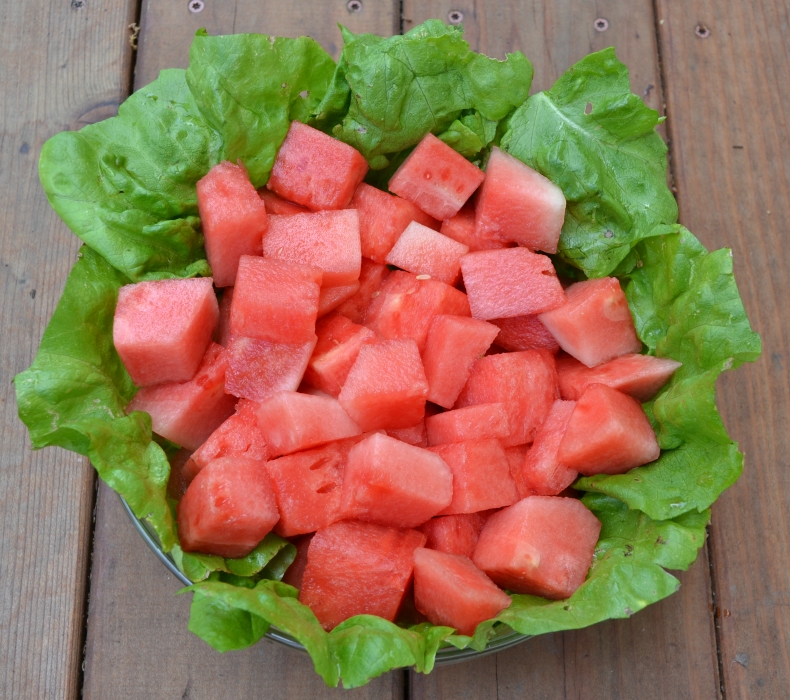 Watermelon season is here! For me, watermelon is totally synonymous with summer fun and enjoying it often brings me to another time and place. My childhood memories of watermelon-soaked backyard gatherings, pool parties, and beach parties abound. In fact, I am eating a watermelon as I am writing this!
Watermelon season is here! For me, watermelon is totally synonymous with summer fun and enjoying it often brings me to another time and place. My childhood memories of watermelon-soaked backyard gatherings, pool parties, and beach parties abound. In fact, I am eating a watermelon as I am writing this!
When I became interested in raw food 25 years ago, watermelon became an actual food for me, rather than a dessert. And just like at summer gatherings, back then I would remove the seeds from the watermelon before eating. Ever heard that old wives' tale that if you eat watermelon seeds they will sprout in your body? Well, we all know that doesn’t happen, but I did grow up thinking watermelon seeds were to be removed before eating the melon.
It wasn’t until college that I learned that those little white watermelon seeds were actually edible. Watermelon is in the cucumber plant family (Cucurbitaceae), along with summer squash, zucchini, winter squash varieties, pumpkin, and other melons such as honeydew and cantaloupe. Pumpkin seeds are famous for their zinc content, so what about watermelon seeds?
Two tablespoons of shelled dry watermelon seeds contain 1.4 mg of zinc, along with 1 mg of iron, 70 mg of magnesium, and more. For only 75 calories, the iron, zinc, and magnesium content of these seeds is excellent. When compared to a similar measure of pumpkin seeds, the zinc content is similar.
| Watermelon seeds – Two tablespoons | Pumpkin seeds – Two tablespoons | Adult DRI | |
| Calories | 75 | 93 | |
| Magnesium | 70 | 92 | 310 – 320 mg for women, 400 – 420 mg for men |
| Iron | 1.0 | 2.6 | 8 mg for men and postmenopausal women, 18 mg for premenopausal women |
| Zinc | 1.4 | 1.3 | 8 mg for women, 11 mg for men |
Most watermelons these days are seedless, but now when I come across the occasional white seed, I eat it along with the watermelon flesh. I do not eat the black seeds largely because I rarely find them. When I do find them, I compost them simply because I do not enjoy their flavor.
What about watermelon itself? Isn’t it controversial for some reason?
To make it easy for people to find reliable information on watermelon and other fruits, the glycemic index, glycemic load, fructose, glucose, and carbohydrates in general, we dedicated a chapter in our book, The Raw Food Nutrition Handbook: An Essential Guide to Understanding Raw Food Diets to answering many common carbohydrate questions.
In the book we also cover other hot topics in raw food nutrition such as essential fats, protein, nutrient content of raw food diets, food combining, enzymes, hydration, vitamins, minerals, and many more. We value education on these important topics and are happy to finally bring this book to you. The book is available on Amazon and other online booksellers.
One of the best ways to keep in touch with us is to join our email list. You’ll receive a free copy of Our Top 12 Strategies for Long Term Success on A Raw Plant-Based Diet eBook along with regular information about raw food and plant-based diets and periodic promotions for our classes, events, and other offerings!
The Green Difference – Five Reasons why Leafy Greens are Important on a Raw Food Diet
Ever since my introduction to raw food 25 years ago, I noticed that there are at any given time a number of raw food enthusiasts who choose to limit their intake of vegetables, especially leafy greens, for various reasons. From my own research, clinical and personal experience, I have found that leaving out these important foods decreases the amounts of important nutrients in one’s diet.
In a recent video I show the content of selected important nutrients in three different smoothies: a fruit smoothie, the same fruit smoothie with dandelion greens added, and the same fruit smoothie with kale added. The nutrient differences between the non-green smoothie and the green smoothies are astonishing, especially for calcium and iron. Here is a chart summarizing the differences:
| Fruit Smoothie | Fruit smoothie plus dandelion greens | Fruit smoothie plus kale | DRI | |
| Calories | 436 | 510 | 536 | |
| Calcium | 110 | 418 | 381 | 1000 mg, 1200 mg |
| Iron | 2.0 | 7.0 | 5.4 | 8 mg, 18 mg |
| Magnesium | 118 | 177 | 136 | 310 mg, 420 mg |
| Potassium | 1484 | 2139 | 2382 | 4700 mg |
| Folate | 157 | 202 | 216 | 400 mcg |
Fruit smoothie recipe:
- One Valencia orange
- Two bananas
- 2 cups pineapple chunks
- ½ cup blueberries
- ½ cup strawberries
- ¼ cup blackberries
Fruit smoothie plus dandelion greens: the ingredients in fruit smoothie with 3 cups of dandelion greens added
Fruit smoothie plus kale: the ingredients in fruit smoothie with 3 cups of chopped kale added
Calcium and Iron: The dandelion greens and kale increase the content of all nutrients listed in the table significantly, especially iron and calcium. The amounts of calcium and iron in the fruit smoothie alone are a good start, but when leafy greens are added, the amounts of these important minerals increase dramatically. Per calorie, the green smoothies are a great value calcium and iron-wise and go a long way in helping to provide the adult DRIs (Dietary Referenced Intakes) for these important nutrients. Without leafy greens, one would be missing out on these nutrients and the health value they provide.
Magnesium: Leafy greens are a reliable source of magnesium because of their chlorophyll content. Chlorophyll is the green coloring that one finds green plants, especially in leaves. The mineral at the center of the chlorophyll molecule is magnesium, so it is not surprising to see that the magnesium content of this smoothie notably increased when leafy greens were added.
Folate: Also known as vitamin B9, folate got its name from the Latin word for foliage, which makes sense given that some strong sources of folate are leafy greens. As evidenced in the table above, adding leafy greens to one’s diet can increase folate intake in many cases significantly. Folate is critical for cell division and DNA replication along with vitamin B12, and has a synergistic relationship with vitamin B12. For clarification of this relationship please see my previous blog post and video on folate and vitamin B12.
Potassium: Fruit is known as a great source of potassium and leafy greens can contain a notable amount of this important alkaline mineral, as the table above indicates.
Many more: There are so many more important nutrients found in leafy greens that we talk about in our book, the Raw Food Nutrition Handbook: An Essential Guide to Understanding Raw Food Diets. Some of these nutrients include the essential omega-3 fat alpha-linolenic acid, carotenoids lutein and zeaxanthin, protein, vitamins C and E, and many more. Many of these important nutrients work together synergistically to create an effect that is greater than the sum of the individual nutrients, so getting them from a whole food source is important. But if we don’t eat the food, we don’t get the nutrients. I see leafy greens and vegetables in general as playing a necessary role in a healthy raw food plant-based diet.
Video summarizing the points covered in this article:
One of the best ways to keep in touch with us is to join our email list. You’ll receive a free copy of Our Top 12 Strategies for Long Term Success on A Raw Plant-Based Diet eBook along with regular information about raw food and plant-based diets and periodic promotions for our classes, events, and other offerings!
The Best Kept Secret about Apricots
While on a 6-mile run yesterday, I found several different types of fruit trees with developing fruits, one of which was an apricot tree. Since it is June, the fruits are still small and green, but later this summer this tree will be packed with beautiful, orange, ripe apricots!
People often think of fruit as being low in important minerals, but what I have found from my research tells a different story. It is important to look at individual fruits and their mineral content before jumping to conclusions. For example, 15 pitted apricots have 70 mg of calcium and 2 mg of iron. It is not unusual for raw food enthusiasts to consume this amount of fruit or more in one sitting, so when considering the daily values, apricots when eaten in quantity can potentially provide a significant amount of these two important minerals.
Apricots, like other fruits such as bananas and dates, are not surprisingly a great source of potassium and 15 pitted apricots contain 1360 mg. For 252 calories worth of food, the amounts of these important minerals can make a great contribution to our daily needs.
| Apricots – 15 pitted | Adult DRI | |
| Calories | 252 | |
| Calcium | 70 mg | 1000 – 1200 mg |
| Iron | 2 mg | 8 mg for men and postmenopausal women18 mg for premenopausal women |
| Potassium | 1360 mg | 4700 mg |
Apricots in-training
________________________________________________________________
One of the best ways to keep in touch with us is to join our email list. You’ll receive a free copy of Our Top 12 Strategies for Long Term Success on A Raw Plant-Based Diet eBook along with regular information about raw food and plant-based diets and periodic promotions for our classes, events, and other offerings!
5 Great Reasons to Add More Fruits and Vegetables to Your Diet
Raw fruits and vegetables are well-known for their health promoting benefits, so much that the current USDA MyPlate suggests that half of our diet be composed of fruits and vegetables. Here are many of the reasons why:
Vitamins
Fruits and vegetables contain many important and synergistic vitamins. Good examples include vitamins C and E. Many fruits and vegetables are excellent sources of vitamin C, including red bell peppers, strawberries, broccoli, cauliflower, papaya, lemons, tomatoes, cantaloupe, and of course, oranges. Leafy greens are rich in both vitamin C and vitamin E, and great sources include romaine lettuce, kale, mustard greens, dandelion greens, and collard greens.
Minerals
Bananas are famous for their potassium content, but fruits in general are great potassium sources. Dates, durian, apricots, honeydew melon, tangerines, oranges, peaches, nectarines, and mangoes are especially high in potassium.
Where do you get your calcium? Where do you get your iron? Many leafy greens can be rich sources of these important minerals, including kale, bok choy, dandelion greens, and even lettuce when eaten in quantity. Three cups of kale or dandelion greens provide over one quarter of the daily value for calcium and notable amounts of iron. A little-known fact is that some fruits can be notable sources of these two minerals as well. For example, only two valencia oranges or 5 figs provide 10% of the daily value for calcium. When eaten in greater quantities than this, as many raw food enthusiasts do, the calcium content can really add up. In regard to iron, although not as rich as leafy greens, mulberries, blackberries, and raspberries when eaten in quantity can provide notable amounts of this important mineral.
Phytonutrients
Plant foods in their fresh, raw state contain numerous phytonutrients, many of which can act as antioxidants which help protect our cells from age accelerating free radicals. Anthocyanins are antioxidants found in blue or purple foods such as blueberries and blackberries. Isothiocyanates are antioxidants found in cabbage family plants, also known as cruciferous vegetables, including collard greens, kale, bok choy, broccoli and Napa cabbage. Lutein and zeaxanthin are yellow-colored antioxidants, and are believed to play a role in protecting the macula of our eyes from damage caused by sunlight-induced free radicals. Lutein and zeaxanthin are found in foods such as dark leafy greens and yellow-orange fruits and vegetables, such as summer squash. Additional rich food sources include kale, Swiss chard, collard greens, romaine lettuce, broccoli, red bell peppers, dandelion greens, and zucchini.
Water
Water is involved in many essential body processes and makes up a significant percentage of body weight. In some raw food menus where fruits and vegetables make up the majority of foods eaten, the water content can be close to a gallon (almost 4 liters) or more! By comparison, raw menus that focus on denser more dehydrated foods, nuts, seeds, or oils can be less than half of this amount. Standard western menus are generally lower still at about one third the quantity of a high fruit and vegetable menu, creating the need for additional water consumption to meet daily needs. Unlike plastic water bottles, fruits and vegetables provide an abundance of healthy water in biodegradable containers!
Fiber
Dietary fiber is the indigestible portion of plant matter that is often referred to as roughage. Fiber plays critically important roles in various aspects of intestinal health, blood sugar and cholesterol regulation, and other important health benefits. Fiber keeps food moving though the intestines. It can help carbohydrates be digested more slowly, which in turn helps to stabilize blood sugar levels. It can bind to excess cholesterol in the digestive tract, helping keep blood cholesterol levels at an appropriate level. Fiber also plays a very important role in maintaining the health of the all-important human microbiome, as it provides food for healthy probiotic bacteria.
And the list goes on…
This is just the beginning! There are so many other reasons to include more fruits and vegetables in one’s diet and we are happy to see that the USDA now emphasizes the importance of these foods to the American public more than ever before.
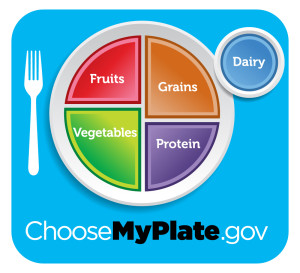
Posted in accordance with USDA MyPlate icon usage guidelines: The USDA does not endorse any products, services, or organizations.
One of the best ways to keep in touch with us is to join our email list. You’ll receive a free copy of Our Top 12 Strategies for Long Term Success on A Raw Plant-Based Diet eBook along with regular information about raw food and plant-based diets and periodic promotions for our classes, events, and other offerings!
The Protein Content of Various Types of Sprouts
Are sprouts as rich in protein as they are rumored to be? How does the protein content of different types of sprouts compare? This video gives a good summary of available information:
One of the best ways to keep in touch with us is to join our email list. You’ll receive a free copy of Our Top 12 Strategies for Long Term Success on A Raw Plant-Based Diet eBook along with regular information about raw food and plant-based diets and periodic promotions for our classes, events, and other offerings!
Where do you get your protein on a raw plant- based vegan diet? A simple answer.
From our experience, this is by far one of the most commonly asked questions of people on raw or plant-based diets. The answer is fortunately quite simple: all plants contain protein. This may come as a surprise for some given that meat is commonly thought to be the sole or main source of protein in food.
Because all plants contain protein, all whole natural plant foods contain protein. Here is a summary of the protein content in a variety of plant foods found on a plant-based diet:
| Type of Food | Carbohydrate | Protein | Fat |
| Sweet Fruit | 89% | 6% | 5% |
| Vegetables | 73% | 18% | 9% |
| Nuts and Seeds | 16% | 11% | 73% |
| Avocados | 19% | 5% | 76% |
| Coconuts | 17% | 4% | 79% |
| Legumes | 66% | 30% | 4% |
| Grains | 80% | 12% | 8% |
| Pseudograins | 71% | 15% | 14% |
| Yams | 92% | 7% | 1% |
| Spirulina | 26% | 64% | 10% |
| Oil | 0 | 0 | 100% |
This chart shows the macronutrient (carbohydrate, protein, and fat) averages in a variety of types of foods as a percentage of calories. Some people may think that fruit does not contain protein, but as we can see, about 6% of the calories in fruit come from protein. Vegetables are higher in protein than fruit and nuts and seeds.
Even coconuts and avocados that are known for their high fat content contain some protein. Legumes are high in protein and low in fat, and can be considered a lean source of protein. In general, pseudograins are higher in protein than grains. True grains are found in the grain or grass family, known as the Poaceae, while pseudograins or pseudocereals including quinoa, amaranth, and buckwheat and are not members of the grain family. Quinoa and amaranth are found in the amaranth plant family (Amaranthaceae) and buckwheat is found in the Polygonaceae plant family.
Yams are well-known for their carbohydrate content and contain 7% of the calories from protein. Spirulina, a cyanobacterium, is the highest of all at 64% of the calories from protein. For more information on spirulina, check out my video. All oils are 100% of the calories from fat, which is one of the many reasons that I encourage people to eat whole natural plant foods, which are some combination of carbohydrate, protein, and fat.
How does this information compare to our protein needs? The World Health Organization suggests that a protein intake of 0.8 g of protein per kilogram of body weight is estimated to cover 97.5 percent of the human population’s needs. For someone who weighs 120 lbs. this would be 44 g of protein per day or 9% of the calories on a 2000 calorie per day diet. For someone who weighs 150 lbs. this would be 54 g of protein or 10% of the calories on a 2200 calorie per day diet. Our daily diets are composed of a combination of whole plant foods that contain more protein than these respective gram measurements and average out to greater than these percentages of calories from protein. Not surprisingly, after a combined 50 + years of living this lifestyle, we feel great.
We encourage you to learn more about this fascinating and often contentious topic, so we further delve into the protein content of raw and plant-based diets in our online Mastering Raw Food Nutrition and Educator Course. For more class details, click here.
Our book The Raw Food Nutrition Handbook: An Essential Guide to Understanding Raw Food Diets addresses plant protein in greater depth and many other hot topics in raw food nutrition such as essential fats, nutrient content of raw food diets, food combining, enzymes, hydration, vitamins, minerals, and many more. We value education on these important topics and are happy to finally bring this book to you. The book is available on Amazon and other online booksellers.
https://www.youtube.com/watch?v=UOlbU1vj9ms&feature=youtu.be
One of the best ways to keep in touch with us is to join our email list. You’ll receive a free copy of Our Top 12 Strategies for Long Term Success on A Raw Plant-Based Diet eBook along with regular information about raw food and plant-based diets and periodic promotions for our classes, events, and other offerings!
Can fruit make a meaningful iron contribution to a raw plant-based diet?
One of the best ways to keep in touch with us is to join our email list. You’ll receive a free copy of Our Top 12 Strategies for Long Term Success on A Raw Plant-Based Diet eBook along with regular information about raw food and plant-based diets and periodic promotions for our classes, events, and other offerings!
Late Summer and Early Fall Fruit Sampler: Blackberries and Figs
In our neighborhood here in northern California, there are many places where we can forage wild blackberries from late summer into fall. When I go out to harvest wild blackberries I am reminded to be mindful of the thorns that these plants have on their stems and leaves. Blackberries are in the rose family, so it is not surprising to find thorns on these plants. Here is a nutrient analysis of one cup of blackberries (144 g):
| Blackberries – 1 cup | Adult Daily Requirements | |
| Calories | 62 | varies |
| Calcium | 42 | 1000 mg, 1200 mg |
| Iron | 0.9 | 8 mg for men and postmenopausal women, 18 mg for premenopausal women |
| Magnesium | 29 | 310 – 320 mg for women, 400 – 420 mg for men |
| Potassium | 233 | 4,700 mg |
| Zinc | 0.8 | 8 mg for women, 11 mg for men |
In reality, I eat more than one cup of blackberries in one sitting, so here is a nutrient analysis of 3½ cups of blackberries (504 g):
| Blackberries – 3½ cups | Adult Daily Requirements | |
| Calories | 217 | varies |
| Calcium | 246 | 1000 mg, 1200 mg |
| Iron | 3.1 | 8 mg for men and postmenopausal women, 18 mg for premenopausal women |
| Magnesium | 101 | 310 – 320 mg for women, 400 – 420 mg for men |
| Potassium | 816 | 4,700 mg |
| Zinc | 2.7 | 8 mg for women, 11 mg for men |
Often, people in the raw food community ask me if fruits are good source of minerals. The answer is that it depends on the fruit and how much one is eating of that fruit. As we can see, blackberries eaten in quantity can be a significant source of the minerals stated in the table above.
Not only can blackberries be a good source of certain important minerals, they are also well known for being a good source of antioxidants. Antioxidants are molecules that can neutralize free radicals before they cause damage to our cells.
A 2006 study measured the antioxidant content of over 1,000 foods and listed the 50 with the highest antioxidant content per 100 grams. Blackberries are number 19 on the list with 3.99 mmol antioxidants per 100 g. Foods that were higher than blackberries include ground cloves, oregano, ginger, cinnamon, turmeric, walnuts, basil, and others. For a full list please watch the video associated with this blog post or view the study listed in the reference section.
There is a challenge with measuring the antioxidant content of foods per 100 grams, given that one must consider how much of these foods one would actually eat in one sitting. Does it make sense that someone is going to eat 100 grams of cloves in one sitting? No, usually when one adds cloves to a recipe, the amount is usually around 1 teaspoon (2.1 grams) or a similar amount. However, it does make sense that one would eat 100 grams of blackberries (a little less than ¾ cup) or much more as mentioned earlier. When antioxidant content was measured per serving size, blackberries topped the list at 5.75 mmol antioxidants per cup, followed by walnuts, strawberries, artichokes, cranberries, and others. Ground cloves were further down on the list at number 10 with 2.64 mmol of antioxidants per teaspoon. Per serving, blackberries had the highest in antioxidants per serving than all other foods tested, which would include other high antioxidant berries like blueberries and raspberries.
What are some of the antioxidants found in blackberries? One type is anthocyanins, which are famous for their blue coloring. Other examples of anthocyanin containing foods include blueberries and raspberries.
Here is a video explaining this information with some added facts on the nutrient content of figs:
References:
Halvorsen BL, Carlsen MH, Phillips KM, Bøhn SK, Holte K, Jacobs DR Jr, Blomhoff R. Content of redox-active compounds (ie, antioxidants) in foods consumed in the United States. Am J Clin Nutr. 2006 Jul;84(1):95-135.
Nutrient content of blackberries: USDA nutrient database
But isn’t fruit controversial for some reason?
To make it easy for people to find reliable information on fruit, the glycemic index, glycemic load, fructose, glucose, and carbohydrates in general, we dedicated a chapter in our book, The Raw Food Nutrition Handbook: An Essential Guide to Understanding Raw Food Diets to answering many common carbohydrate questions.
In the book we also cover other hot topics in raw food nutrition such as essential fats, protein, nutrient content of raw food diets, food combining, enzymes, hydration, vitamins, minerals, and many more. We value education on these important topics and are happy to finally bring this book to you. The book is available on Amazon and other online booksellers.
One of the best ways to keep in touch with us is to join our email list. You’ll receive a free copy of Our Top 12 Strategies for Long Term Success on A Raw Plant-Based Diet eBook along with regular information about raw food and plant-based diets and periodic promotions for our classes, events, and other offerings!
My Top Five Favorite Leafy Greens
One of the best ways to keep in touch with us is to join our email list. You’ll receive a free copy of Our Top 12 Strategies for Long Term Success on A Raw Plant-Based Diet eBook along with regular information about raw food and plant-based diets and periodic promotions for our classes, events, and other offerings!
What is so great about dandelion greens?
One of the best ways to keep in touch with us is to join our email list. You’ll receive a free copy of Our Top 12 Strategies for Long Term Success on A Raw Plant-Based Diet eBook along with regular information about raw food and plant-based diets and periodic promotions for our classes, events, and other offerings!
Beta-carotene absorption and conversion to vitamin A on a raw plant-based vegan diet
 Where does one get vitamin A on a plant-based vegan diet?
Where does one get vitamin A on a plant-based vegan diet?
Vitamin A is essential for proper cell growth and reproduction and is probably best known for its importance in vision. It also plays an important role in immune system function and skin health. Vitamin A (also known as retinol) is found exclusively in animal foods and various vitamin supplements. Vitamin A is an essential nutrient for humans, so if one is eating a vegan diet, where is this vitamin A obtained? Fortunately, the human body converts beta-carotene and certain other carotenoids to vitamin A when necessary. Beta-carotene is a well-known carotenoid famous for providing carrots with their orange coloring and is found in many other plant foods, especially green, yellow, and orange-colored fruits and vegetables.
Beta-carotene conversion to vitamin A
How does this conversion of beta-carotene to vitamin A work? In the human body, beta-carotene is converted to retinal by a dioxygenase enzyme. Retinal is then converted to retinol (vitamin A) by a dehydrogenase enzyme:
Other carotenoids that are capable of converting to vitamin A in the human body include alpha-carotene, gamma-carotene, and beta-cryptoxanthin. Of the four carotenoids, the one that converts the most reliably to vitamin A is beta-carotene.
Why is my skin orange?
Vitamin A is a fat-soluble nutrient, which means that it can be stored in our body and we run the risk of getting too much from outside sources, such as supplements consumed in excess of the body’s needs. Carotenoids are fat soluble also, but do not carry the same risks as vitamin A with excess consumption. In excess of the body’s needs, carotenoids are stored in fat cells including those under our skin, giving an orange color to the skin which is only cosmetic.
Do we have to cook our food to get enough beta-carotene and vitamin A?
Many people have asked about the effectiveness of this carotenoid conversion mechanism and how well carotenoids are absorbed from raw food. A recent study found normal vitamin A status and favorable blood beta-carotene levels in 200 long-term raw food enthusiasts. This indicates is that these raw foodists consumed a good amount of beta-carotene, a quantity was absorbed and was present in their bloodstream, and then an appropriate amount was converted into vitamin A.
References:
Fleshman, Matthew Kintz. Beta Carotene Absorption and Metabolism. Ph.D. dissertation, Ohio State University, 2011.
Garcia A, Koebnick C, Dagnelie P, Strassner C, Elmadfa I, Katz N, Leitzmann C, Hoffman I. British Journal of Nutrition 2008; 99: 1293 – 1300.
Interested in taking your vitamin A, beta-carotene, and general nutrition knowledge to the next level?
We cover this topic and so much more in our online Mastering Raw Food Nutrition and Educator Course. For more class details, click here.
Additionally, our book The Raw Food Nutrition Handbook: An Essential Guide to Understanding Raw Food Diets addresses many hot topics in raw food nutrition such as essential fats, protein, nutrient content of raw food diets, food combining, enzymes, hydration, vitamins, minerals, and many more. We value education on these important topics and are happy to finally bring this book to you. The book is available on Amazon and other online booksellers.
One of the best ways to keep in touch with us is to join our email list. You’ll receive a free copy of Our Top 12 Strategies for Long Term Success on A Raw Plant-Based Diet eBook along with regular information about raw food and plant-based diets and periodic promotions for our classes, events, and other offerings!
The Calcium Content of Fruit
One of the best ways to keep in touch with us is to join our email list. You’ll receive a free copy of Our Top 12 Strategies for Long Term Success on A Raw Plant-Based Diet eBook along with regular information about raw food and plant-based diets and periodic promotions for our classes, events, and other offerings!
Is Lettuce a Superfood?
One of the best ways to keep in touch with us is to join our email list. You’ll receive a free copy of Our Top 12 Strategies for Long Term Success on A Raw Plant-Based Diet eBook along with regular information about raw food and plant-based diets and periodic promotions for our classes, events, and other offerings!
Video on the Vitamin E content in Raw and Roasted Almonds
One of the best ways to keep in touch with us is to join our email list. You’ll receive a free copy of Our Top 12 Strategies for Long Term Success on A Raw Plant-Based Diet eBook along with regular information about raw food and plant-based diets and periodic promotions for our classes, events, and other offerings!
Video on the Selenium Content of Brazil Nuts
One of the best ways to keep in touch with us is to join our email list. You’ll receive a free copy of Our Top 12 Strategies for Long Term Success on A Raw Plant-Based Diet eBook along with regular information about raw food and plant-based diets and periodic promotions for our classes, events, and other offerings!


